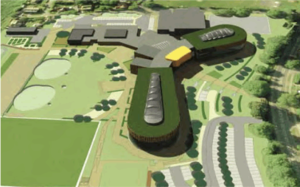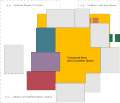School Design: Difference between revisions
From DT Online
m (Removed a category) |
(Corrected Category) |
||
| (4 intermediate revisions by the same user not shown) | |||
| Line 1: | Line 1: | ||
[[File:ProjectFaraday.png|300px|right|Project Faraday example school|link=http://www.goved.co.uk/projects/faraday]] | |||
'''[[Design and Technology]]''' is about changing the made world and touches on all the skills needed to create new environments - including schools! | '''[[Design and Technology]]''' is about changing the made world and touches on all the skills needed to create new environments - including schools! | ||
| Line 7: | Line 10: | ||
The following guidance is intended only to provide some vocabulary and starting points and to take the opportunity to think about some basic principles. | The following guidance is intended only to provide some vocabulary and starting points and to take the opportunity to think about some basic principles. | ||
* Some interesting web sites that show examples of school design (click on titles to view) : | * Some interesting web sites that show examples of school design ''(click on titles to view)'' : | ||
** [https://en.wikipedia.org/wiki/Building_Schools_for_the_Future '''Building Schools for the Future ''(BSF)'']''' was the name given to the UK government's investment programme in school buildings in the 2000s | |||
** [http://webarchive.nationalarchives.gov.uk/20110118095356/http://www.cabe.org.uk/schools '''CABE'''] - the government’s advisor on architecture,urban design and public space from 1999 to 2011. | ** [http://webarchive.nationalarchives.gov.uk/20110118095356/http://www.cabe.org.uk/schools '''CABE'''] - the government’s advisor on architecture,urban design and public space from 1999 to 2011. | ||
** [http://www.fieldingnair.com/ '''Fielding Nair International'''] - educational facilities planning and architectural design and the developers of [http://goodschooldesign.com/ '''EFEI'''] - an assessment tool that measures how well educational facilities are able to support best-practice. | ** [http://www.fieldingnair.com/ '''Fielding Nair International'''] - educational facilities planning and architectural design and the developers of [http://goodschooldesign.com/ '''EFEI'''] - an assessment tool that measures how well educational facilities are able to support best-practice. | ||
** [http://schooldesigns.com/ '''US School Design'''] - a virtual gallery of American School & University magazine's Architectural Portfolio and Educational Interiors Showcase issues. | ** [http://schooldesigns.com/ '''US School Design'''] - a virtual gallery of American School & University magazine's Architectural Portfolio and Educational Interiors Showcase issues. | ||
---- | |||
[[Category:Management and Planning]] | |||
[[Category:Environments]] | |||
[[ | |||
[[Category: | |||
Latest revision as of 15:23, 22 April 2016
Design and Technology is about changing the made world and touches on all the skills needed to create new environments - including schools!
Look at your own school and imagine you were involved in its design - or perhaps you would like to think about how it could be improved? Look at schools built 50yrs ago . . . and 100yrs ago . . . what might they look like 50yrs from now?
The following guidance is intended only to provide some vocabulary and starting points and to take the opportunity to think about some basic principles.
- Some interesting web sites that show examples of school design (click on titles to view) :
- Building Schools for the Future (BSF) was the name given to the UK government's investment programme in school buildings in the 2000s
- CABE - the government’s advisor on architecture,urban design and public space from 1999 to 2011.
- Fielding Nair International - educational facilities planning and architectural design and the developers of EFEI - an assessment tool that measures how well educational facilities are able to support best-practice.
- US School Design - a virtual gallery of American School & University magazine's Architectural Portfolio and Educational Interiors Showcase issues.
Pages in category "School Design"
The following 6 pages are in this category, out of 6 total.
Media in category "School Design"
The following 8 files are in this category, out of 8 total.
- AreaDataSheetExtract2.jpg 500 × 334; 104 KB
- CampusPlan3.png 1,075 × 687; 67 KB
- DTplan2.png 1,253 × 820; 583 KB
- HellerupCirculationSpace.jpg 523 × 351; 189 KB
- ScienceGarden.jpg 386 × 281; 96 KB
- SquarePlan3.png 715 × 614; 52 KB
- StreetPlan3.png 1,190 × 475; 57 KB
- ZonePlan2.png 1,192 × 690; 322 KB







